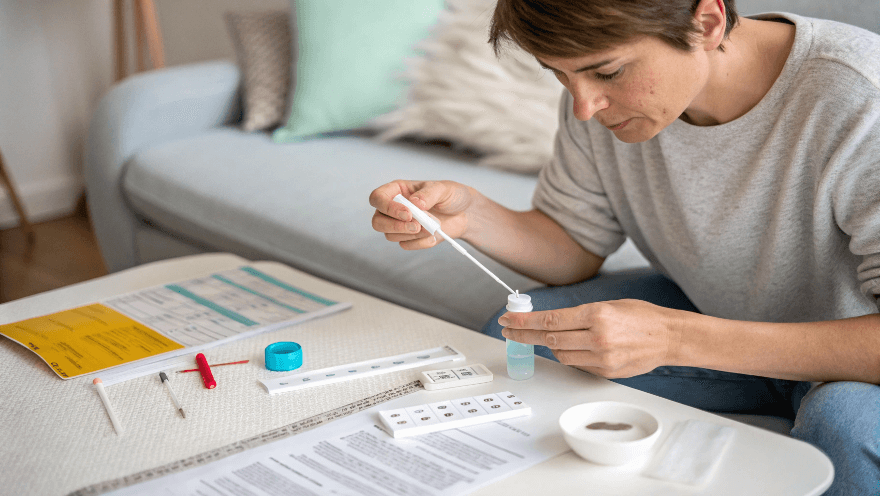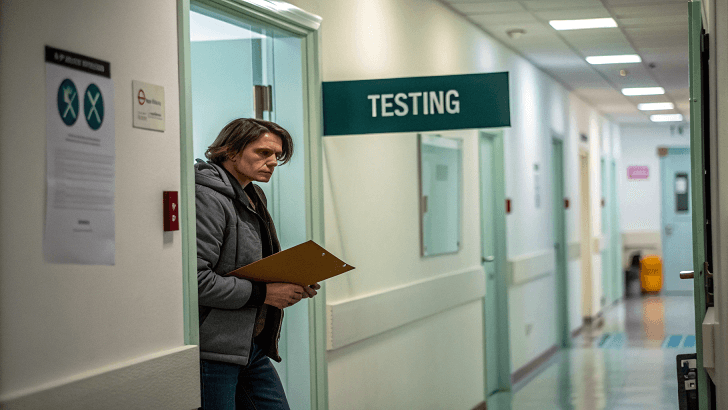Testování na pohlavně přenosné choroby je pravděpodobně jednou z nejlepších věcí, které můžete pro své zdraví udělat, ale pokud jde o výběr způsobu jeho provedení, můžete se cítit zmateni.
Zavoláte na kliniku, nebo si necháte udělat test na pohlavně přenosné choroby doma? Obě možnosti jsou dobré a volba je na vás a musí být učiněna podle vašich potřeb, vašeho stylu a vašich pocitů pohodlí. V tomto průvodci tomu tak není. Nebudeme vám jen představovat seznam výhod a nevýhod. Rozebereme si je však, poskytneme vám snadno čitelnou tabulku srovnání vašich možností a ukážeme vám reálné situace, abyste se s jistotou rozhodli, kterou z nich si vybrat. Dokonce vám ukážeme, jak integrovat přístup, který nyní mnozí preferují, a to kombinaci testování doma a testování na pohlavně přenosné choroby v klinice podle potřeby.
Pojďme začít.
Stručný přehled: Srovnávací tabulka
| Funkce | Domácí testování | Testování v klinikách |
| Pohodlí | Vysoká (Hotovo kdykoli a kdekoli) | Nízká (Vyžaduje schůzku, cestování) |
| Soukromí | Maximální (plně soukromý proces) | Vysoká (právně chráněné, ale veřejné prostředí) |
| Náklady | Liší se (často nižší vpředu) | Liší se (pojištění může pokrýt, případné spoluúčasti) |
| Přesnost | Vysoká (pokud byly pokyny přesně dodrženy) | Velmi vysoká (profesionální odběr vzorků) |
| Rozsah testu | Omezené (obvykle běžné pohlavně přenosné infekce) | Komplexní (k dispozici je široká škála testů) |
| Okamžitá podpora | Žádné (Výsledky doručeny online/telefonicky) | Vysoká (Okamžitý přístup ke zdravotnickému pracovníkovi) |
| Následná akce | Povinné (pro pozitivní výsledky je nutné navštívit lékaře) | Integrovaná (léčba může často začít okamžitě) |
Domácí testování na pohlavně přenosné choroby
Zajímá vás, co obnáší domácí test na pohlavně přenosné choroby? Zde je to, co můžete očekávat, to dobré i špatné:
Co to je a jak to funguje
Domácí test na pohlavně přenosné choroby vám umožní provést test na časté infekce z pohodlí domova. Objednáte si ho online, odeberete si vlastní vzorek (například moč, krev z prstu nebo tampon) a poté vzorek odešlete zpět do certifikované laboratoře. Výsledky jsou obvykle k dispozici online nebo telefonicky do 4–7 dnů.

Výhody (když je to skvělá volba)
Největší výhodou domácího testování na pohlavně přenosné choroby je pohodlí. Není nutné se objednávat ani si brát volno z práce a čekat v čekárně. Další obrovskou výhodou je soukromí, žádné nepříjemné diskuse ani náhodné schůzky v jedné z blízkých klinik pro testování na pohlavně přenosné choroby. Je to diskrétní, rychlé a vhodné pro rutinní screeningy.
Nevýhody (na co si dát pozor)
Domácí testy se spoléhají na správný odběr vzorku. Jakékoli chyby, jako je dotyk tamponu nebo nedostatečné naplnění krevní lahvičky, mohou ovlivnit výsledky, což odborníci zdůrazňují jako klíčové omezení metod samoodběru. Článek o medicíně UAB popisuje, jak mohou chyby při odběru vzorků vést k falešně pozitivním nebo negativním výsledkům.
Většina souprav testuje nejběžnější pohlavně přenosné choroby (jako jsou chlamydie, kapavka, HIV, syfilis), což je v souladu se standardními doporučeními pro rutinní screening stanovenými CDC, ale nemusí se vztahovat na méně časté infekce. A pokud budete mít pozitivní test, budete i tak muset navštívit lékaře nebo kliniku, kde vám poskytnou testy na pohlavně přenosné choroby, aby vám je potvrdili a podstoupili léčbu.
Testování na pohlavně přenosné choroby v ambulanci
I když je soukromí stále prioritou, ale nejdůležitější je přesnost, zůstává pro mnohé návštěva kliniky pro testování na pohlavně přenosné infekce důvěryhodným standardem.
Co to je a jak to funguje
Testování na pohlavně přenosné choroby v klinikách znamená návštěvu kliniky pro testování na pohlavně přenosné choroby, praktického lékaře nebo kliniky pro vyšetření a odběr vzorku. Zdravotnický pracovník odebere vzorek, odešle jej do laboratoře a probere s vámi výsledky, obvykle osobně nebo prostřednictvím zabezpečeného portálu.

Výhody (zlatý standard péče)
Testování v ambulanci zůstává zlatým standardem přesnosti. Vzorky vám odebírá vyškolený personál, což snižuje počet chyb uživatelů. Máte přístup k širší škále testů, včetně kultivací a screeningu na méně časté pohlavně přenosné infekce. Pokud se výsledek ukáže jako pozitivní, mnoho klinik může okamžitě zahájit léčbu nebo vás odkázat ke specialistovi. Tato úroveň péče je důvodem, proč mnoho lidí stále důvěřuje klinikám před jednoduchým rychlotestem na pohlavně přenosné infekce doma.
Nevýhody (potenciální bariéry)
Pro mnohé je největší výzvou čas a logistika – plánování, dojíždění, sezení v čekárně. Někteří lidé se cítí nepříjemně, když mluví o svém sexuálním životě s cizím člověkem, dokonce i s lékařem. Kliniky sice ze zákona chrání vaše soukromí, ale není to totéž jako testování ve vlastním domě.
Hybridní přístup: Získání toho nejlepšího z obou světů
Faktem je, že si nemusíte vybrat jednu nebo druhou možnost. Větší počet lidí nyní používá domácí testovací sady na pohlavně přenosné choroby v kombinaci s návštěvami kliniky, aby si zajistili ideální kombinaci soukromí, pohodlí a spolehlivosti.
Příklad: Můžete začít používáním důvěryhodného produktu pro domácí použití jednou za 3–6 měsíců, abyste si udrželi své sexuální zdraví pod kontrolou. Pokud je váš test pozitivní nebo se u vás objeví neobvyklý výtok, bolest nebo vřídky, ihned se necháte otestovat na klinice pro testování na pohlavně přenosné choroby nebo v ambulantním centru pro testování na pohlavně přenosné choroby.
Je to dobrá cesta pro ty, kteří chtějí mít jistotu pravidelných návštěv bez nepříjemností spojených s pravidelnou návštěvou kliniky, ale přesto touží po profesionální podpoře, když je to nutné.
Průvodce scénáři: Která testovací metoda je pro VÁS nejlepší?
Rozhodnutí, zda si nechat udělat testy na pohlavně přenosné choroby doma, nebo jít na kliniku, záleží na vás. Zde je návod, jak se snadno rozhodnout.
Scénář A: Upřednostňujete soukromí a nemáte žádné příznaky
Domácí test na pohlavně přenosné choroby může být tou správnou volbou, v závislosti na tom, že vaší hlavní prioritou je naprosté soukromí a jste v dobrém stavu. Často se provádí kvůli všední jistotě klidu.
Scénář B: Máte aktivní příznaky
Nečekejte, zvláště pokud zažíváte vředy, abnormální výtok, bolest při sexu nebo jakékoli jiné nepříjemné příznakyNavštivte místní kliniku pro pohlavně přenosné choroby nebo kliniku bez objednání. Pro okamžitou léčbu potřebujete lékařské vyšetření, odbornou diagnózu a dokonce i rychlý test na pohlavně přenosné choroby.
Scénář C: Potřebujete výsledky testů pro konkrétní účel
Někdy potřebujete doklad o testování kvůli práci, pojištění, imigraci nebo cestování. V těchto případech jsou testy v klinice téměř vždy vyžadovány, protože k nim je přiložena oficiální dokumentace. Vždy si nejprve ověřte přesná pravidla.
Scénář D: Máte nabitý program a chcete rutinní screening
Pokud je život hektický, ale přesto chcete zůstat zodpovědní, použijte hybridní přístup. Provádějte si doma vícepanelové testování na pohlavně přenosné choroby každé pár měsíců a spojte ho s každoroční klinickou prohlídkou, abyste odhalili vše, co by test mohl přehlédnout.
Často kladené otázky
- Můžu si nechat udělat test na pohlavně přenosné choroby doma?
Ano – dnešní domácí testy na pohlavně přenosné choroby jsou diskrétní, cenově dostupné a pohodlné. Odeberete vzorek, zašlete ho poštou do laboratoře a výsledky získáte bezpečně online.
- Jsou domácí testy na pohlavně přenosné choroby přesné?
Ano. Domácí testovací sady na pohlavně přenosné choroby v laboratoři jsou velmi přesné, pokud přesně dodržujete pokyny. Největším rizikem je chyba uživatele během odběru. Pokud si nejste jisti nebo pokud dosáhnete pozitivního výsledku, obraťte se na kliniku.
- Mohu využít pojištění pro domácí testy na pohlavně přenosné choroby?
Záleží na tom. Některé pojišťovny hradí domácí testy nebo vám umožňují využít finanční prostředky z HSA/FSA. Vždy se nejprve poraďte se svou pojišťovnou a společností, která test prováděla.
- Co mám dělat ihned po pozitivním výsledku domácího testu?
Pokud máte pozitivní výsledek domácího testu, nepanikařte. Objednejte se na potvrzovací test v klinice pro testování na pohlavně přenosné infekce nebo v ambulanci, poraďte se s poskytovatelem zdravotní péče o léčbě, vyhněte se sexuální aktivitě a naplánujte si, jak budete informovat své partnery.
- Mohu se nechat otestovat na pohlavně přenosné infekce v klinice bez objednání?
Ano – kliniky s bezplatnou konzultací často nabízejí testování na pohlavně přenosné choroby v ten samý den bez objednání. To je skvělá volba, pokud potřebujete okamžitou péči nebo nechcete čekat.
Poslední krok: Přijetí opatření a komunikace výsledků
Nakonec je „nejlepší“ test ten, který si skutečně necháte udělat. Ať už si vyberete domácí test na pohlavně přenosné choroby, nebo návštěvu kliniky, testování je zodpovědným prvním krokem k vašemu zdraví a zdraví vašich partnerů.
Ale je tu ještě jeden krok, který je stejně důležitý: informovat své partnery, pokud máte pozitivní test. To nikdy není snadný rozhovor. Proto služby jako Řekněte svému partnerovi existují. Umožňují vám poslat anonymní a uctivé oznámení, aby se vaši partneři také mohli nechat otestovat, bez nepříjemných nebo riskantních konfrontací.
Dávejte na sebe pozor. Chraňte ostatní. Nechte se otestovat a komunikujte zodpovědně – vše začíná zde.
💡Prohlášení: Tento blog poskytuje obecné informace a nenahrazuje odbornou lékařskou pomoc; ohledně diagnózy a léčby se prosím poraďte s kvalifikovaným poskytovatelem zdravotní péče.

 Anonymy
Anonymy
 Gentell
Gentell




